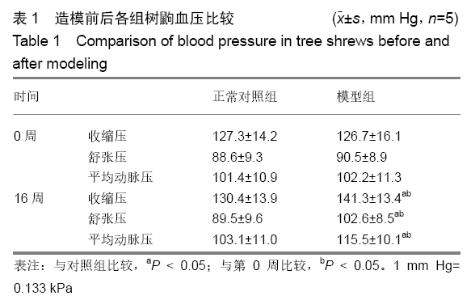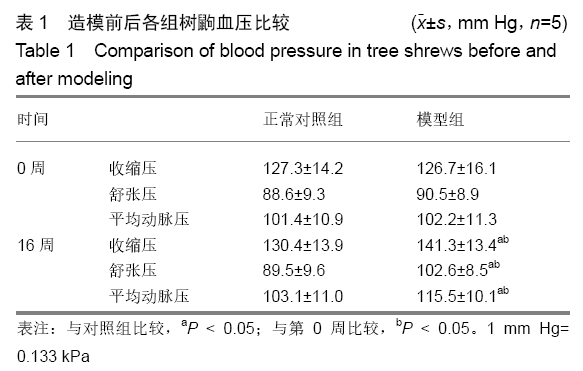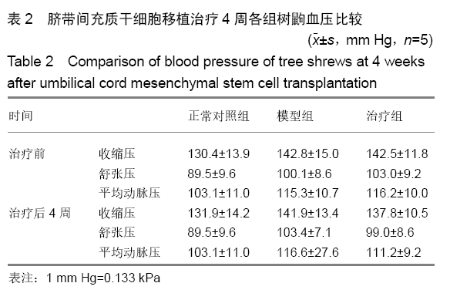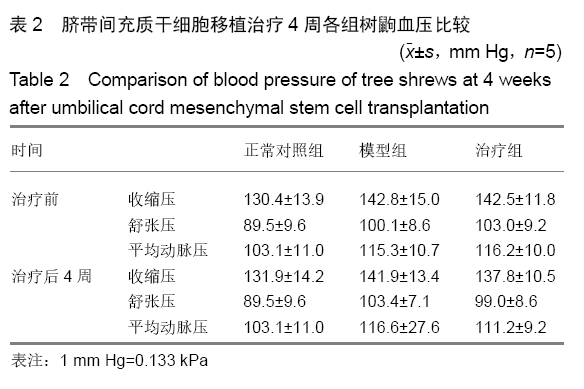Chinese Journal of Tissue Engineering Research ›› 2020, Vol. 24 ›› Issue (1): 51-58.doi: 10.3969/j.issn.2095-4344.1861
Previous Articles Next Articles
Allogeneic umbilical cord mesenchymal stem cell transplantation for metabolic syndrome in a tree shrew model
Ruan Guangping1, 2, 3, Yao Xiang1, 2, 3, Cai Xuemin1, 2, 3, Li Zian1, 2, 3, Pang Rongqing1, 2, 3, Pan Xinghua1, 2, 3
- 1The Cell Biological Therapy Center of 920th Hospital of Joint Logistics Support Force of PLA, Kunming 650032, Yunnan Province, China; 2The Integrated Engineering Laboratory of Cell Biological Medicine of State and Regions, Kunming 650032, Yunnan Province, China; 3The Transfer Medicine Key Laboratory of Cell Therapy Technology of Yunan Province, Kunming 650032, Yunnan Province, China
-
Received:2019-03-13Revised:2019-03-21Accepted:2019-04-19Online:2020-01-08Published:2019-12-11 -
Contact:Pan Xinghua, MD, Chief physician, The Cell Biological Therapy Center of 920th Hospital of Joint Logistics Support Force of PLA, Kunming 650032, Yunnan Province, China; The Integrated Engineering Laboratory of Cell Biological Medicine of State and Regions, Kunming 650032, Yunnan Province, China; The Transfer Medicine Key Laboratory of Cell Therapy Technology of Yunan Province, Kunming 650032, Yunnan Province, China -
About author:Ruan Guangping, MD, Associate chief physician, The Cell Biological Therapy Center of 920th Hospital of Joint Logistics Support Force of PLA, Kunming 650032, Yunnan Province, China; The Integrated Engineering Laboratory of Cell Biological Medicine of State and Regions, Kunming 650032, Yunnan Province, China; The Transfer Medicine Key Laboratory of Cell Therapy Technology of Yunan Province, Kunming 650032, Yunnan Province, China -
Supported by:the Major Science and Technology Project of Yunnan Science and Technology Plan Project, No. 2018ZF007; Yunnan Province Key Projects, No. 2018FA041, 2017FA040, and 2015FA039
CLC Number:
Cite this article
Ruan Guangping, Yao Xiang, Cai Xuemin, Li Zian, Pang Rongqing, Pan Xinghua. Allogeneic umbilical cord mesenchymal stem cell transplantation for metabolic syndrome in a tree shrew model[J]. Chinese Journal of Tissue Engineering Research, 2020, 24(1): 51-58.
share this article
Add to citation manager EndNote|Reference Manager|ProCite|BibTeX|RefWorks

2.2 代谢综合征模型建立及脐带间充质干细胞治疗结果 2.2.1 一般情况 模型组40只树鼩,最终有32只成模。模型组树鼩与正常对照组比较,出现毛色灰暗、尾部溃疡坏死、多饮、腹泻、反应迟钝、活动度差等症状;正常对照组树鼩活跃、反应灵敏,无上述症状;而治疗组树鼩在治疗后2周尾部溃疡开始愈合,腹泻减少,活动度增加,反应较模型组树鼩灵敏。 2.2.2 空腹血糖水平变化 高糖高胆固醇高盐饲料饲喂4周,模型组树鼩空腹血糖相比对照组已有升高;8周时,模型组树鼩空腹血糖均值已达10 mmol/L以上。注射链脲佐菌素后空腹血糖达到11.1 mmol/L以上,并维持在一个较高水平[模型组:(25.50±4.50) mmol/L;正常对照组:(4.19± 0.77) mmol/L,P < 0.01]。脐带间充质干细胞治疗后树鼩空腹血糖较模型组及治疗前明显下降,并随时间延长呈下降趋势,但未能降至正常对照组正常水平,见图2。 "

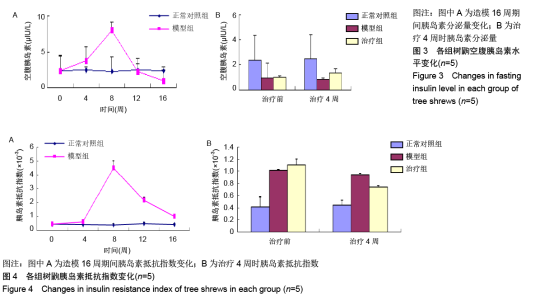
2.2.3 空腹胰岛素水平变化 从高糖高胆固醇高盐饲料饲喂开始,模型组空腹胰岛素水平就呈上升趋势,高饲8周时,模型组树鼩胰岛素水平达到高峰,注射链脲佐菌素后,进一步破坏了胰岛β细胞,使细胞出现变性坏死,其分泌功能开始失代偿,胰岛素分泌量开始下降至低于正常对照组水平[模型组:(0.96±0.11) μIU/L;正常对照组:(2.37± 1.92) μIU/L,P < 0.01],见图3A。脐带间充质干细胞治疗后4周,治疗组树鼩胰岛素分泌量明显增加[治疗组:(1.34±0.33) μIU/L;模型组:(0.85±0.10) μIU/L,P < 0.05],差异有显著性意义,见图3B。 2.2.4 胰岛素抵抗指数变化 高糖高胆固醇高盐饲料饲喂8周时,模型组树鼩已表现出明显的胰岛素抵抗[模型组:(4.50±0.51)×10-3,正常对照组:(0.40±0.10)×10-3,P < 0.01],注射链脲佐菌素后,由于持续的高水平空腹血糖使得胰岛功能开始失代偿,胰岛素水平下降,胰岛素抵抗指数也较前降低,但仍明显高于正常对照组[模型组:(1.01±0.02)×10-3,正常对照组:(0.44±0.07)×10-3,P < 0.01],见图4A。治疗后4周,治疗组树鼩胰岛素抵抗指数由(1.10±0.10)×10-3降至(0.74±0.02)×10-3,较治疗前降低,差异有显著性意义(P < 0.05),见图4B。 "
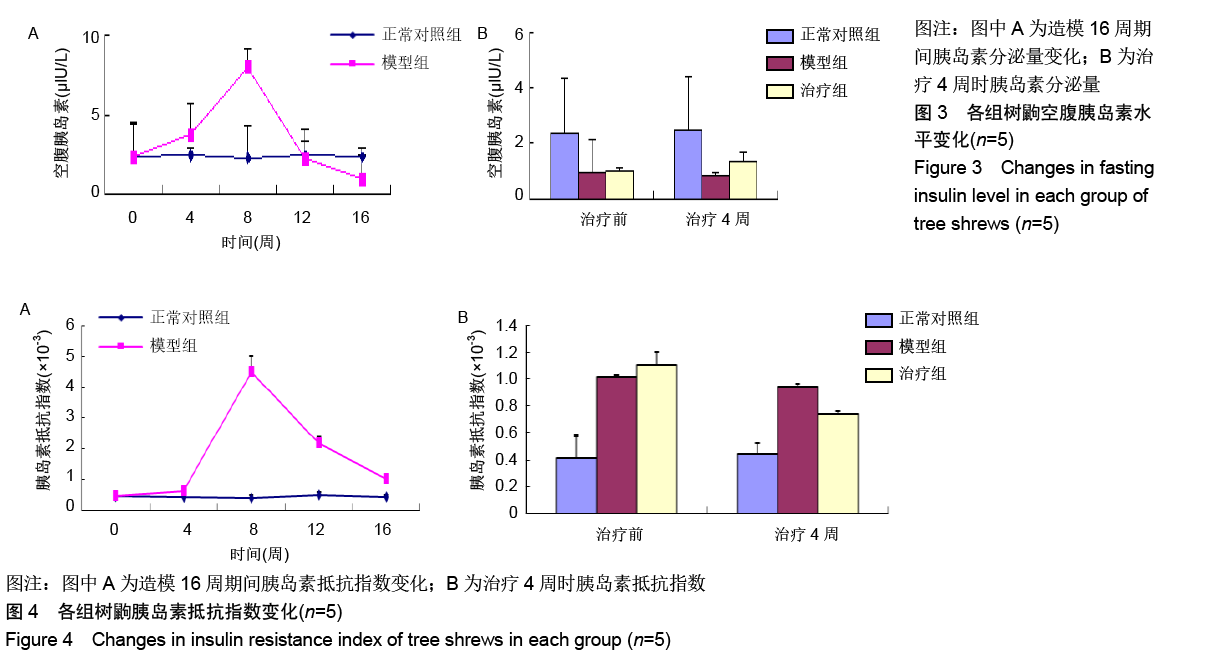
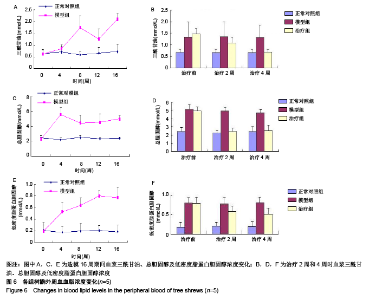
2.2.6 血浆三酰甘油、总胆固醇及低密度脂蛋白胆固醇浓度变化 高糖高胆固醇高盐饲料饲喂1周,模型组树鼩的三酰甘油、总胆固醇及低密度脂蛋白胆固醇都开始升高,第4周时明显升高,差异有显著性意义;此后整个造模过程中呈现出不稳定的升高趋势,三酰甘油由(0.63±0.17) mmol/L上升至(2.11±0.23) mmol/L,总胆固醇由(2.31± 0.29) mmol/L上升至(5.57±0.94) mmol/L;低密度脂蛋白胆固醇从高饲1周开始即一直保持明显的升高趋势,由(0.20±0.14) mmol/L上升至(0.77±0.18) mmol/L;正常对照组树鼩血脂在造模过程中并无差异性变化,见图6A,C,E。以上表明模型组树鼩血脂代谢紊乱。脐带间充质干细胞治疗后血脂明显降低,三酰甘油由(1.49±0.23) mmol/L降至(0.71±0.09) mmol/L,总胆固醇由(4.97±0.48) mmol/L降至(2.51±0.73) mmol/L,低密度脂蛋白胆固醇由(0.79± 0.16) mmol/L降至(0.51±0.17) mmol/L,与治疗前及模型组相比差异有显著性意义(P < 0.01),见图6B,D,F。"
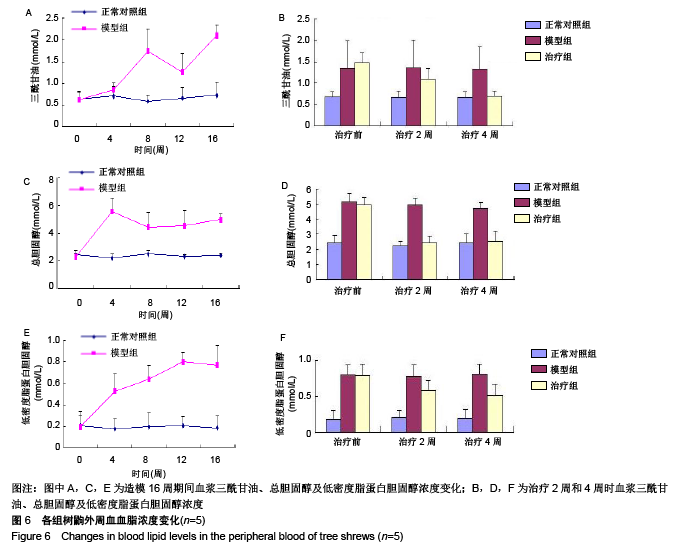
| [1] REAVEN GM. Banting lecture 1988. Role of insulin resistance in human disease. Diabetes. 1988;37(12):1595-1607. [2] ZHANG Y, SHEN W, HUA J, et al. Pancreatic islet-like clusters from bone marrow mesenchymal stem cells of human first-trimester abortus can cure streptozocin-induced mouse diabetes. Rejuvenation Res. 2010; 13(6):695-706. [3] WEN Y, CHEN B, ILDSTAD ST. Stem cell-based strategies for the treatment of type 1 diabetes mellitus. Expert Opin Biol Ther. 2011;11(1): 41-53. [4] 刘静,赵冬,刘军,等. 代谢综合征与自由脂肪酸的关系[J]. 中华心血管病杂志, 2005,33(7):653-657. [5] 岳松,田凤石.代谢综合征的诊断标准和防治研究进展[J]. 天津医药, 2011, 39(8):770-773. [6] PROWSE AB, CHONG F, GRAY PP, et al. Stem cell integrins: implications for ex-vivo culture and cellular therapies. Stem Cell Res. 2011;6(1):1-12. [7] REYES M, DUDEK A, JAHAGIRDAR B, et al. Origin of endothelial progenitors in human postnatal bone marrow. J Clin Invest. 2002; 109(3):337-346. [8] 阮光萍,朱路,刘菊芬,等. 树鼩脐带间充质干细胞分离、培养及成骨成脂分化的鉴定[J].中国组织工程研究, 2017,21(9):1373-1377. [9] 周晖,高彦彬,罗文益,等. 中西医结合治疗Ⅱ型糖尿病合并代谢综合征病例回顾研究[J].中国民族民间医药,2009,18(1):73-75. [10] ZHU H, SONG X, JIN LJ, et al. Comparison of intra-coronary cell transplantation after myocardial infarction: Autologous skeletal myoblasts versus bone marrow mesenchymal stem cells. J Int Med Res. 2009;37(2):298-307. [11] CHEN B, QIN MC, HUANG JL, et al. Preliminary establishment of integration of Alzheimer's disease and blood stasis syndrome tree shrew model and evaluation of intervention of Panax notoginseng saponins. Zhongguo Zhong Yao Za Zhi. 2017;42(6):1175-1182. [12] JIANG LP, SHEN QS, YANG CP, et al. Establishment of basal cell carcinoma animal model in Chinese tree shrew (Tupaia belangeri chinensis). Zool Res. 2017;38(4):180-190. [13] FENG Y, FENG YM, LU C, et al. Tree shrew, a potential animal model for hepatitis C, supports the infection and replication of HCV in vitro and in vivo. J Gen Virol. 2017;98(8):2069-2078. [14] XIAO J, LIU R, CHEN CS. Tree shrew (Tupaia belangeri) as a novel laboratory disease animal model. Zool Res. 2017;38(3):127-137. [15] TONG Y, HAO J, TU Q, et al. A tree shrew glioblastoma model recapitulates features of human glioblastoma. Oncotarget. 2017;8(11): 17897-17907. [16] FAN Y, LUO R, SU LY, et al. Does the Genetic Feature of the Chinese Tree Shrew (Tupaia belangeri chinensis) Support Its Potential as a Viable Model for Alzheimer's Disease Research. J Alzheimers Dis. 2018;61(3):1015-1028. [17] LI R, YUAN B, XIA X, et al. Tree shrew as a new animal model to study the pathogenesis of avian influenza (H9N2) virus infection. Emerg Microbes Infect. 2018;7(1):166. [18] LI R, ZANIN M, XIA X, et al. The tree shrew as a model for infectious diseases research. J Thorac Dis. 2018;10(Suppl 19):S2272-S2279. [19] SAMUELS BC, SIEGWART JT, ZHAN W, et al. A Novel Tree Shrew (Tupaia belangeri) Model of Glaucoma. Invest Ophthalmol Vis Sci. 2018;59(7): 3136-3143. [20] ZHENG H, NIU S, ZHAO H, et al. Donepezil improves the cognitive impairment in a tree shrew model of Alzheimer's disease induced by amyloid-β1-40 via activating the BDNF/TrkB signal pathway. Metab Brain Dis. 2018;33(6):1961-1974. [21] WU KH, YANG SG, ZHOU B, et al. Human umbilical cord derived stem cells for the injured heart. Med Hypotheses. 2007;68(1):94-97. [22] LIEW CG, ANDREWS PW. Stem cell therapy to treat diabetes mellitus. Rev Diabet Stud. 2008;5(4):203-219. [23] XIN L, LIN X, PAN Y, et al. A collagen scaffold loaded with human umbilical cord-derived mesenchymal stem cells facilitates endometrial regeneration and restores fertility. Acta Biomater. 2019 May 7. doi: 10.1016/j.actbio.2019.05.012.[Epub ahead of print] [24] BOUGIOUKLI S, SAITTA B, SUGIYAMA O, et al. Lentiviral Gene Therapy for Bone Repair Using Human Umbilical Cord Blood-Derived Mesenchymal Stem Cells. Hum Gene Ther. 2019 Apr 22. doi: 10.1089/hum.2018.054. [Epub ahead of print] [25] PARK YB, HA CW, KIM JA, et al. Comparison of Undifferentiated Versus Chondrogenic Predifferentiated Mesenchymal Stem Cells Derived From Human Umbilical Cord Blood for Cartilage Repair in a Rat Model. Am J Sports Med. 2019;47(2):451-461. [26] WU X, XU L, SHEN Y, et al. MALP-2, an agonist of TLR6, promotes the immune status without affecting the differentiation capacity of umbilical cord mesenchymal stem cells. Exp Ther Med. 2017;14(6): 5540-5546. [27] MAIA L, DE MORAES CN, DIAS MC, et al. A proteomic study of mesenchymal stem cells from equine umbilical cord. Theriogenology. 2017;100:8-15. [28] YANG Y, WANG Y, LI L, et al. Activation of the Toll-like receptor 8 pathway increases the immunogenicity of mesenchymal stem cells from umbilical cord. Mol Med Rep. 2017;16(2):2061-2068. [29] ASGARI HR, AKBARI M, YAZDEKHASTI H, et al. Comparison of Human Amniotic, Chorionic, and Umbilical Cord Multipotent Mesenchymal Stem Cells Regarding Their Capacity for Differentiation Toward Female Germ Cells. Cell Reprogram. 2017;19(1):44-53. [30] GAO X, SONG L, SHEN K, et al. Transplantation of bone marrow derived cells promotes pancreatic islet repair in diabetic mice. Biochem Biophys Res Commun. 2008;371(1):132-137. |
| [1] | Chen Ziyang, Pu Rui, Deng Shuang, Yuan Lingyan. Regulatory effect of exosomes on exercise-mediated insulin resistance diseases [J]. Chinese Journal of Tissue Engineering Research, 2021, 25(25): 4089-4094. |
| [2] | Ruan Guangping, Yao Xiang, Liu-Gao Miyang, Cai Xuemin, Li Zian, Pang Rongqing, Wang Jinxiang, Pan Xinghua. Umbilical cord mesenchymal stem cell transplantation for traumatic systemic inflammatory response syndrome in tree shrews [J]. Chinese Journal of Tissue Engineering Research, 2021, 25(25): 3994-4000. |
| [3] | Liu Yulin, Li Guotai. Combined effects of hyperbaric oxygen, vibration training and astaxanthin on bone mineral density, glucose metabolism and oxidative stress in diabetic osteoporosis rats [J]. Chinese Journal of Tissue Engineering Research, 2021, 25(20): 3117-3124. |
| [4] | Sun Weixing, Zhao Yongchao, Zhao Ranzun. Mesenchymal stem cell transplantation in the treatment of myocardial infarction: problems, crux and new breakthrough [J]. Chinese Journal of Tissue Engineering Research, 2021, 25(19): 3103-3109. |
| [5] | Chen Xiao, Guo Zhi, Chen Lina, Liu Xuanyong, Zhang Yihuizhi, Li Xumian, Wang Yueqiao, Wei Liya, Xie Jing, Lin Li. Factors affecting the mobilization and collection of autologous peripheral blood hematopoietic stem cells [J]. Chinese Journal of Tissue Engineering Research, 2021, 25(19): 2958-2962. |
| [6] | Zhang Chuanhui, Li Jianjun, Yang Jun. Effects of dynamic pressure on the proliferation and mechanical properties of rabbit adipose mesenchymal stem cells transfected with insulin-like growth factor-1 [J]. Chinese Journal of Tissue Engineering Research, 2021, 25(13): 1982-1987. |
| [7] | Cao Linlin, Ding Kaiyang, Song Hao, Wu Guolin, Hu Maogui, Fan Dandan, Zhou Chenyang, Wang Cuicui, Feng Yuanyuan. Efficacy and influencing factors of autologous hematopoietic stem cell transplantation in the treatment of malignant lymphoma [J]. Chinese Journal of Tissue Engineering Research, 2021, 25(13): 1993-1998. |
| [8] | Zhang Wenjian, Ma Lingfu, Wang Zhimin, Mo Wenjian, Zhou Ruiqing. Muscle mass evaluation and influencing factors of sarcopenia in allogeneic hematopoietic stem cell transplantation patients [J]. Chinese Journal of Tissue Engineering Research, 2021, 25(13): 1999-2004. |
| [9] | Qian Nannan, Zhang Qian, Yang Rui, Ao Jun, Zhang Tao. Mesenchymal stem cells in the treatment of spinal cord injury: cell therapy and combination of new drugs and biomaterials [J]. Chinese Journal of Tissue Engineering Research, 2021, 25(13): 2114-2120. |
| [10] | Guo Xuan, Xie Jun, Suo Jinrong, Li Yingrui, Huang Lei, Ma Munan, Li Jingjing, Fu Songtao. Transplantation of islet-like cells induced by human umbilical cord mesenchymal stem cells via different ways for the treatment of type 1 diabetic mice [J]. Chinese Journal of Tissue Engineering Research, 2021, 25(1): 78-83. |
| [11] | Ruan Guangping, Yao Xiang, Cai Xuemin, Li Zian, Pang Rongqing, Pan Xinghua. Effect of umbilical cord mesenchymal stem cell transplantation for treating systemic lupus erythematosus in a tree shrew model [J]. Chinese Journal of Tissue Engineering Research, 2021, 25(1): 90-95. |
| [12] | Zang Jing, Luan Zuo, Wang Qian, Yang Yinxiang, Wang Zhaoyan, Wu Youjia, Guo Aisong. Two kinds of stem cell nasal transplantation for treating white matter injury in premature rat infants [J]. Chinese Journal of Tissue Engineering Research, 2021, 25(1): 101-107. |
| [13] | Jing Yucheng, Wang Le, Wang Xianyun, Wei Mei, Li Min, Ji Lishuang, Ma Fangfang, Liu Gang , Zheng Mingqi. Umbilical cord mesenchymal stem cell transplantation in the treatment of ischemic heart disease: a 3-year follow-up [J]. Chinese Journal of Tissue Engineering Research, 2021, 25(1): 6-12. |
| [14] | Zhu Bingbing, He Haibin, Deng Jianghua, Wang Wenqiang, Mu Xiaoling. Human umbilical cord mesenchymal stem cells overexpressing interleukin 8 receptor inhibit inflammation and promote vascular repair [J]. Chinese Journal of Tissue Engineering Research, 2021, 25(1): 61-66. |
| [15] | Chen Ganghong, Zeng Chaoming, Chen Ziming, Liao Junxing, Ma Yuanchen, Zheng Qiujian . Intra-articular injection of optimal concentration of bone marrow mesenchymal stem cells for treating rabbit cartilage defects [J]. Chinese Journal of Tissue Engineering Research, 2020, 24(7): 996-1001. |
| Viewed | ||||||
|
Full text |
|
|||||
|
Abstract |
|
|||||






